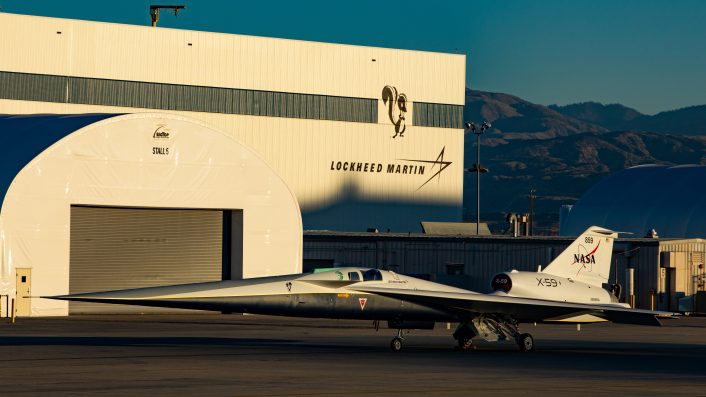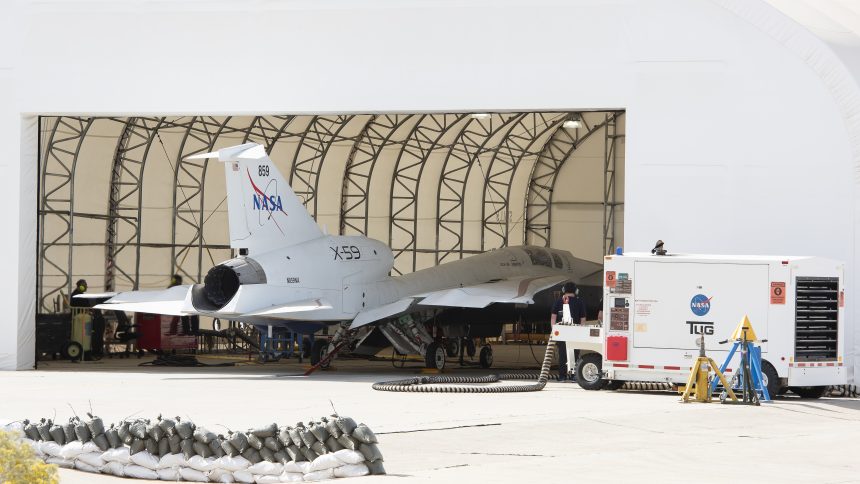X-59’s engine started for testing for the first time.
NASA’s Quesst (“Quiet SuperSonic Technology”) mission recently achieved a key milestone as it began testing the engine that will power the X-59, an experimental supersonic aircraft developed by Skunk Works for NASA’s Low-Boom Flight Demonstrator project.
The first engine tests, which were carried out on Oct. 30, 2024 at Lockheed Martin’s Skunk Works facilities in Palmdale, allow the X-59 team to validate that all aircraft systems work together under the power of the one-of-a-kind aircraft’s engine, as opposed to previous tests that relied on external power sources. These engine tests are a crucial step towards preparing the X-59 for its maiden flight.
According to NASA, the testing is being done in stages, with the first phase involving low-speed engine rotation without ignition to check for leaks and ensure that all systems are communicating properly. After verifying these systems, the team fueled the aircraft and began low-power engine tests to ensure smooth operation without issues or leaks.
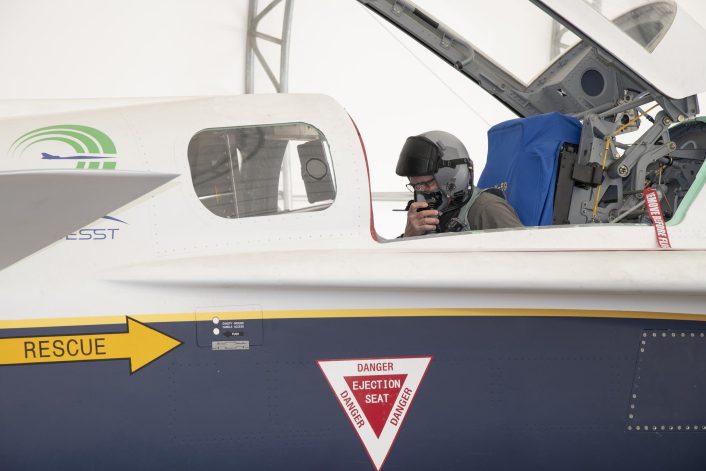
Jay Brandon, NASA’s X-59 chief engineer, explained:
This first phase of engine testing was a warmup to confirm everything looked good before running the engine.
We then conducted the initial engine start, which took the engine out of preservation mode since its installation. This first start was an opportunity to ensure the engine and related systems—like hydraulics, electrical, and environmental controls—were all working as expected.
Supersonic air travel disappeared with the end of the former-Soviet Tupolev Tu-144 supersonic transport and the famous joint French and English Concorde SST built by Aérospatiale/BAC. The Soviets had little success with their SST program, which predated the first Concorde flight by three months but only remained operational from 1975 until 1978. The Anglo-French Concorde was significantly more successful, flying commercially from 1976 until 2003 when it was retired after a tragic crash on July 25, 2000, at Charles de Gaulle Airport in Paris, France. At the time, neither program achieved a high degree of economic efficiency and both suffered from the constraints of traditional supersonic flight.
New low-boom technology, that works by using an elongated fuselage that (more or less) mutes the sonic boom, should make the X-59 able to fly at 1.4 times the speed of sound, or 925 mph, at 55,000 feet generating a quieter sonic thump than the undesirable and potentially damaging “traditional” loud sonic booms, that are prohibited for commercial flights during overland flight.
For 50 years, the U.S. and other nations have prohibited such flights because of the disturbance caused by loud, startling sonic booms on the communities below. The X-59, is an experimental aircraft 99.7 feet long and 29.5 feet wide flown by a single pilot, designed to generate a quieter sonic boom which should be within acceptable noise levels to help the FAA to lift the ban on commercial supersonic travel over land imposed in 1973: according to NASA, the sonic boom generated by the new aircraft will be less than 75 perceived dB on the ground, about a third less than the Concorde, which was reported around 100-110 dB.
New low-boom technology, using an extended fuselage to soften the sonic boom aims to produce a gentler “sonic thump” rather than the loud booms that led to bans on supersonic flights over land.
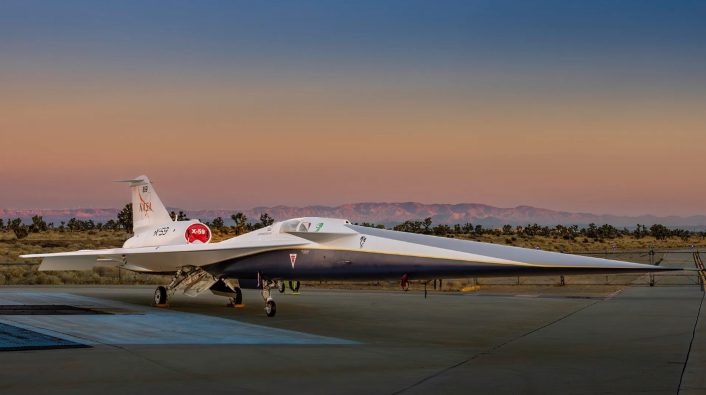
Powered by a modified F414-GE-100 engine with 22,000 pounds of thrust, the X-59 is expected to reach Mach 1.4, or 925 mph, at 55,000 feet. The engine’s unusual placement on top of the aircraft helps reduce noise.
The pilot will fly the aircraft using a unique cockpit design without a conventional forward-facing window. Instead, a central 4K monitor acts as the “window,” giving the pilot a clear view of surrounding air traffic and offering visual guidance for approaches, landings, and takeoffs. This monitor, a key component of the aircraft’s eXternal Visibility System (XVS), shows stitched-together images from two external cameras combined with terrain data from an advanced computer system. While the cockpit includes real windows on the sides and a traditional canopy to help the pilot maintain a view of the horizon, displays below the XVS screen provide essential information on aircraft systems and trajectory to ensure safe flight.
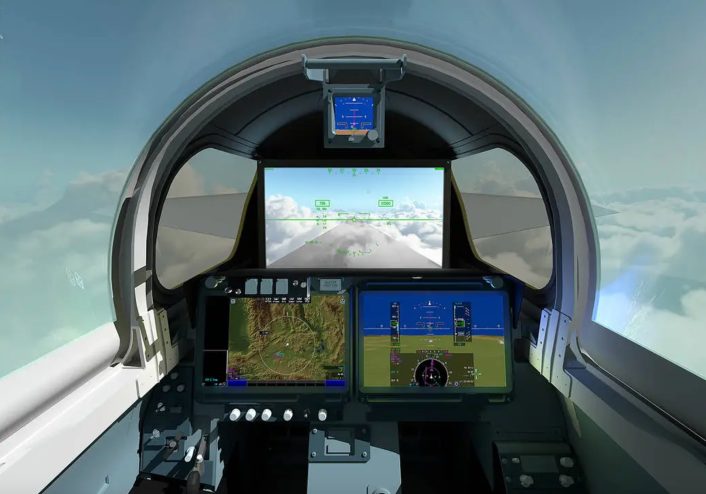
In May this year, an independent Flight Readiness Review board, consisting of experts from various parts of NASA, completed aasessing the X-59 project team’s safety protocols for protecting both the public and staff during ground and flight tests. This review involved a thorough examination of the team’s analysis of potential risks, with particular attention to safety measures and risk assessment.
The Flight Readiness Review was a crucial step in the initial phase of securing flight approval.
The more recent engine tests are part of a broader series of ground checks essential for ensuring safe and effective flight. With these significant testing milestones in progress, the first flight is anticipated in early 2025. The team will continue through critical ground tests, solving any technical issues that may arise with this unique aircraft, aiming to pinpoint a specific date for the first flight as testing progresses.
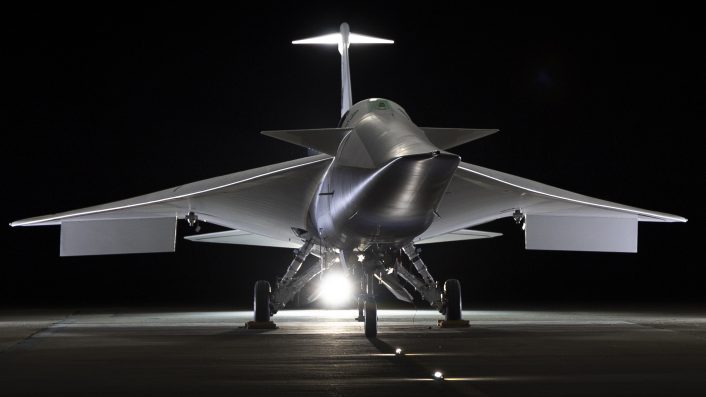
Testing is taking place at Lockheed Martin’s Skunk Works facility in Palmdale, California. In later phases, the team will test the engine at higher power levels with quick throttle changes and replicate real flight conditions.
The success of these tests represents the culmination of eight years of my career. This is just the start of our journey. It’s like hearing the first note of a symphony—years of teamwork are now being tested, and we’re eager to see the project come together as we progress toward flight.
Paul Dees, NASA’s deputy propulsion lead for the X-59.
Following engine tests, the X-59 team will conduct aluminum bird tests, providing data on both regular and simulated failure conditions. They’ll then conduct taxi tests, moving the aircraft on the ground, and complete final steps leading up to its maiden flight.
After the first flight, the aircraft will conduct its first quiet supersonic flight then the Quesst team will conduct several of the aircraft’s flight tests at Skunk Works before transferring it to NASA’s Armstrong Flight Research Center in Edwards, California, which will serve as its base of operations. After the successful completion of the flight tests, NASA plans to fly the X-59 aircraft over several cities across the U.S. to collect data about the sound generated by the experimental airplane and how people perceive it from the ground. NASA will provide that data to the Federal Aviation Administration and international regulators.
